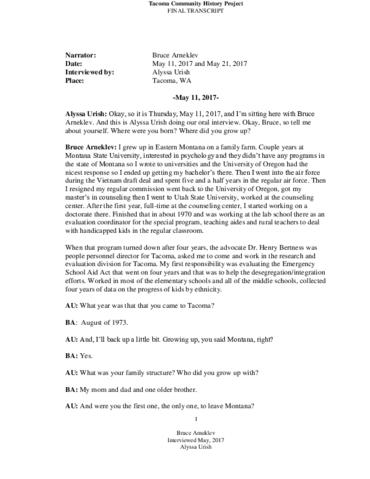Identity elements
Reference code
Name and location of repository
Level of description
Item
Title
Perspectives on Tacoma School Desegregation: From Family Values to Program Evaluation
Date(s)
- 2017 (Creation)
Extent
Content and structure elements
Scope and content
Oral history interview with Bruce Arneklev by Alyssa Urish conducted 05/11/2017,05/21/2017. Born in rural, eastern Montana, Bruce Arneklev, 79, can be seen as an unlikely match to have led the Tacoma School District's desegregation program evaluation in the 1970s. Arneklev earned his bachelor's and master's degrees at the University of Oregon and his Educational Doctorate in educational psychology at Utah State University before moving out with his family of five for an evaluation role with the Tacoma School District. Arneklev was hired to evaluate the district's Emergency School Aid Act for its first four years, 1973-1977. ESAA was a federal program that funded school desegregation efforts. Tacoma began voluntarily desegregating its schools in 1966 with a limited school choice enrollment for its segregated central-area schools and expanding to district-wide enrollment policies to reduce effects of de facto segregation over the next three years. Arneklev worked for an additional twelve years in the district's evaluation department before working as a school psychologist for ten years, retiring in 2000. He lives in the North End of Tacoma with his wife, Dixie, dog, Charlie and has several children and grandchildren in the Tacoma area.
System of arrangement
Conditions of access and use elements
Conditions governing access
Technical access
Conditions governing reproduction
Individuals may use project materials for scholarly or research purposes, according to the provisions of fair use, but reproducing, publishing, or broadcasting any oral history project materials requires permission. No use beyond limited quotation for educational and research purposes should be made of these interviews and other materials without obtaining written permission. For more information, contact the University of Washington Tacoma Library.
Languages of the material
Scripts of the material
Language and script notes
Finding aids
Acquisition and appraisal elements
Custodial history
Immediate source of acquisition
Appraisal, destruction and scheduling information
Accruals
Existence and location of originals
This oral history is a part of the University of Washington Tacoma Community History Project. To access additional content related to this interview, see the UWT Digital Collections.

